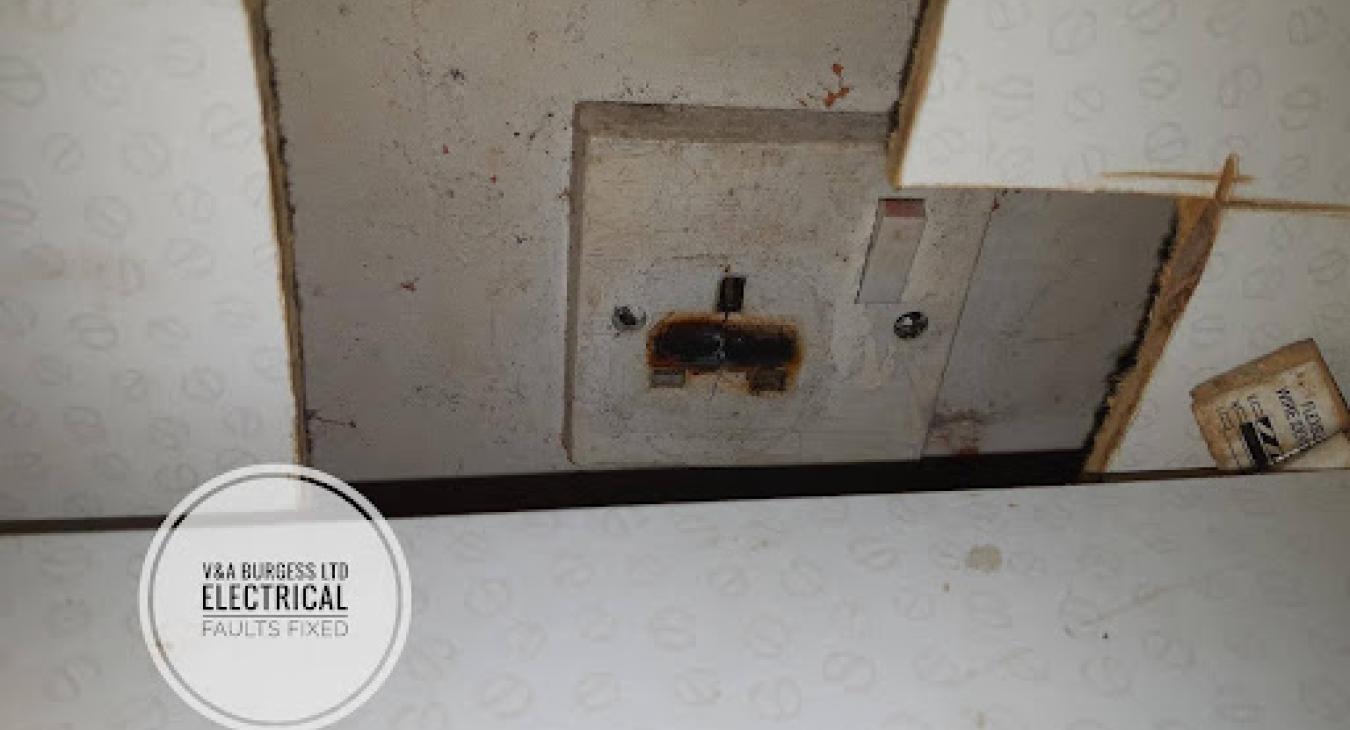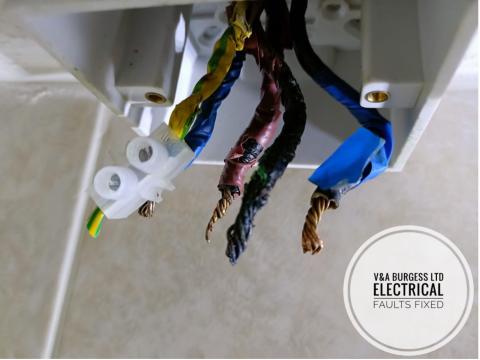
1) What would cause a plug to get warm & is it dangerous?
Pictured here we have a socket that has suffered some damage from overheating and burning. Plugs are normally the cause for this type of damage. The damage caused to the plug socket outlet pictured above is showing classic signs of a loose fuse and an over-heating plug fuse holder. If you have a warm plug then it a possible fire hazard. Check for a brown mark on a moulded plug or on the plug pins as this is a dangerous sign that overheating is occurring.
Back to top2) What is a plug?
A plug is the means of connecting an electrical appliance to the power in your home. In this case the plug at the end of the appliance connects into the plug socket (pictured here) and then gains the connection to the electricity supply from the socket.
Plugs are normally plastic or PVC moulded construction and normally contain three pins which slot into a plug socket. Inside an electrical plug there is a fuse, or at least most of the time there should be. Occasionally in cheap import plugs from other parts of the world there are no fuses and often the plugs are designed dangerously giving an increased risk of electrical danger.
The fuse inside a plug is designed to blow when there is a problem with the appliance rather than relying on the mains trip switch or fuse. The size of a fuse in a plug will vary depending upon the appliance the plug and cable are protecting and powering.
Back to top3) LITTLE BIT OF SCIENCE HERE SORRY!!
- Fuse ratings are given in amps.
- An amp is a unit of electrical current.
- As an example, 50 modern LED light bulbs will typically require 1 amp of current.
- In a table lamp there will usually be a 3-amp fuse. A 3-amp fuse will allow a lot more electrical current to the lamp than the lamp actually draws but that’s ok. The fuse is there to protect the cable to the appliance and to aid in the event of an electrical fault.
In a kettle there will often be a 13-amp fuse. This is a bigger fuse than the table lamp as the kettle requires much more power and therefore a bigger fuse and a thicker cable is needed to allow the full power to be drawn safely.
Under normal operation, plug tops should not get excessively warm or hot.
As an appliance uses power, an electrical current flows through the fuse. This causes the fuse to get warm and in turn can warm up the plug and the socket.
4) How warm is too warm?
All electrical cabling and accessories have a safe operating temperature and under normal circumstances this is never exceeded. The electrician that designed and installed your electrical system in your home would have made some electrical design decisions based on calculations to ensure that your electrical needs never exceeded the capabilities of your electrical system preventing overheating and risk of fire. HOWEVER, there are occasions when things can go wrong.
High powered appliances and plug tops can join forces with worn out sockets, loose connections, and overuse to cause overheating! The resistance of their contact points is often very high due to worn metals, corrosion, and dirt and this causes excessive heat due to the higher resistance. This leads to a burning smell and brown marks appearing.
For instance, a plug top with a 13-amp fuse can only handle 10 amps continuously. What does this mean? Well, it means that whilst the fuse will allow 13 amps to pass safely it will warm up whilst this happens and if the appliance or electrical equipment is using 13 amps for a long period then the plug top or fuse may get warm or quite hot!
Did you know that a 13-amp fuse will actually allow 20 amps to pass through without ever blowing?!!!!
This is a problem.
We regularly see 13-amp fuses used for immersion switches and double sockets in kitchens that power two heavy power-hungry appliances. These burn out regularly and damage wiring behind and the solution is often a little bit of redesign.
Back to top5) What about sockets?
This is an interesting one (subjective I know) and if you are anything like me, you will now go and check all the plugs in your house! 😊 Most double sockets (that allow two plugs to be plugged in) are only really capable of delivering 13 amps of current safely. That means that there may be problems if a dishwasher and washing machine for example are plugged in to the same socket! Each typically requiring 10-13 amps at times.
In reality these appliances don’t tend to draw their 10-13 amps at exactly the same time or if they do it is not for very long so most sockets tend to survive just fine. Issues begin to arise when appliances are used heavily, the electrical system is old and has not been checked by an electrician for a long time.
Back to top6) Should cables get warm?
Electrical cabling can get warm during use. As electrical current flows through the cables it generates heat which will pass from the copper wire inside the cable to the outside of the cable and its covering. This is normal especially for larger appliances or circuits. Cables should never really get hot though, this can be a problem. If a cable gets hot it can cause a variety of issues.
Hot cables can:
- Melt their insulation
- Melt their sheath / covering
- Cause fires
- Heat can travel down the copper to electrical accessories and melt terminals
- Indicate that there are problems in your electrical system
7) I am worried about my plugs and electrics
It is understandable to worry about your electrical system, particularly if it is getting a bit older. The important thing to understand is that we are here to help. We can check your electrical system is safe and advise on any problems that we can see.
We are always happy to offer free advice and assistance where we can. For instance, if you are worried about a particular appliance / socket then you can email us or WhatsApp a photograph to us and we will have a peek for you.
If you want your electrical system fully checked out and a full written in-depth report produced, we can also do that for you. Just have a look at our electrical inspection page (EICR) and you will find lots of information about electrical checks and what is involved (https://www.electricalfaultsfixed.co.uk/electrical-safety-checks-eicr)
Likewise, if you don’t want the expense of a full electrical check, we can carry out a limited visual inspection only. Whilst this may offer some peace of mind, the results and information we can provide based on this are far more limited. A visual inspection is only recommended where your electrical system has been regularly checked in the past or is under 10 years old.
Back to top8) What can I do to prevent issues like this?
And this...
The best thing to do to prevent problems is to actively maintain the electrical system as best as you can.
This involves some do it yourself tasks such as:
- Checking the condition of plug socket outlets – Check electrical socket outlets carefully for signs of cracking between pin holes, cracking around the edges, discolouration, and any bubbling of the plastic. All these signs can indicate overheating either behind where the wiring is or on the plug that is inserted into the socket outlet.
- Checking the condition of appliance plugs – Appliance plugs can become damaged, overheated, cracked, or otherwise altered from the manufacturer’s specification. If there are any signs of thermal damage or mechanical damage on the plug top then it should be replaced. If the appliance has an aftermarket plug rather than a moulded plug fitted, it is a good idea to remove the screw and double check the connections inside to ensure that the plug is wired correctly and the connections are tight and well made. There is a great article HERE (https://www.electricalfaultsfixed.co.uk/blog/plug-wiring-uk-step-step-guide) which shows you how a plug should be wired correctly.
- Ensuring switches don’t become ‘spongy’ – When switches on plug sockets, wall switches and other electrical equipment start to become very worn they can develop a spongy feel to them. This is where the distinctive ‘click’ has disappeared the resistance of their contact has increased drastically and high heat is likely to develop as the flow of electricity is made more difficult by the resistance of the connections. There is a sort of non-committal smooth or loose motion to the whole operation. This is telling you it’s time to replace some electrical accessories.
- Making sure sockets don’t become overloaded – Ensuring that plug sockets are not under too much stress is VITAL to preventing plugs and plug socket outlets from becoming warm and overheating. Where sockets are subject to too many electrical appliances it can create overheating and melting.
- Don't overload socket outlets - When too many high-power appliances are used on a power strip, extension cord or in the same wall socket, they can easily overload plug socket outlet. Small appliances running at maximum power can quickly exceed the maximum safe limit of a standard outlet or extension lead. Possibly the most common cause of an overloaded outlet is multiple extensions leads providing too much current across too many appliances.
- Don't do DIY Electrics - By using a professional electrician to carry out any electrical work in your home, you ensure that the electrical devices installed will be done correctly in accordance with wiring regulations. This limits the risk of a short circuit or a loose fit on the wiring from occurring. An electrician will also carry out a series of tests on the power supply, internal wiring, and the circuit breaker. Part of these tests is making sure that the resistance of the connection to each electrical accessory is good.
Have old plug socket outlets replaced- In older homes it is common to find issues on the plug socket electrical circuit such as:
- Faulty Wiring
- Loose Connection
- Bad Connection
- High Resistance
- Faulty Electrical Outlets
If you have different sockets throughout your home, it may be a sign that an older outlet has failed and has been replaced. Whilst new plug socket outlets may not have a lot of great new features, replacing them with brand new models does mean that the risk of a poor connection, loose contacts and electrical fires are reduced considerably.
Back to top









